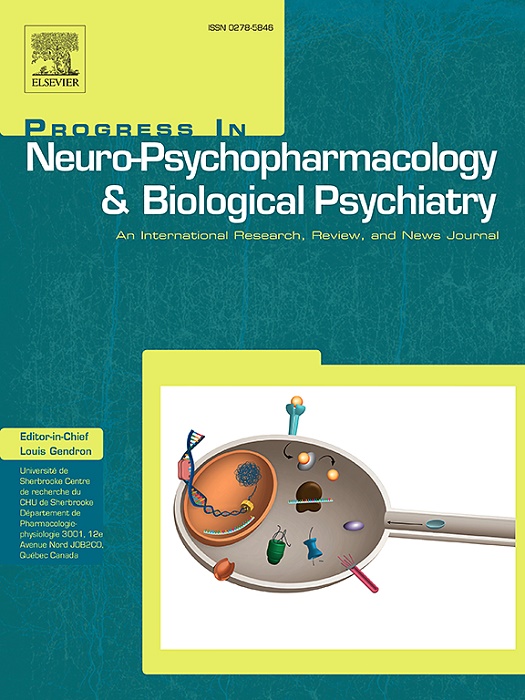尿酸代谢和脑功能障碍将童年虐待与青少年情绪障碍的自残联系起来。
IF 3.9
2区 医学
Q1 CLINICAL NEUROLOGY
Progress in Neuro-Psychopharmacology & Biological Psychiatry
Pub Date : 2025-07-26
DOI:10.1016/j.pnpbp.2025.111460
引用次数: 0
摘要
背景:儿童虐待(CM)可能通过尿酸(UA)失调和UA介导的神经功能障碍增加自残行为(SHB)的风险。针对这些机制可能为预防战略提供有价值的见解。方法:本研究分析540例伴有情绪障碍和重度抑郁发作的青少年住院患者(12-18 岁,女性占74.6 %),分为SHB组(N = 397)和NSHB组(N = 143)。多模式评估包括临床评估、血清尿酸定量、静息状态功能磁共振成像(rs-fMRI)和平均低频波动幅度(mALFF)分析。分析包括组间比较、逻辑回归和结构方程模型(SEM)来确定SHB途径。结果:逐步回归发现血清UA升高是SHB的保护因素(β = -0.011,P 校正 )。结论:我们的研究结果表明,儿童虐待通过UA相关的代谢失调和中颞回活性降低,增加了SHB的风险,强调嘌呤代谢和颞回回路是精确干预的有希望的目标。本文章由计算机程序翻译,如有差异,请以英文原文为准。
Uric acid metabolism and brain dysfunction linking childhood maltreatment to self-harm in adolescents with mood disorders
Background
Childhood maltreatment (CM) elevates self-harm behavior (SHB) risk, potentially through uric acid (UA) dysregulation and UA-mediated neural dysfunction. Targeting these mechanisms may offer valuable insights into preventive strategies.
Methods
This study analyzed 540 adolescent inpatients (12–18 years, 74.6 % female) with mood disorders and major depressive episodes, stratified into SHB (N = 397) and NSHB (N = 143) groups. Multimodal assessments incorporated clinical evaluations, serum UA quantification, and resting-state functional magnetic resonance imaging (rs-fMRI) with mean amplitude of low-frequency fluctuations (mALFF) analysis. Analyses encompassed between-group comparisons, logistic regression, and structural equation modeling (SEM) to identify SHB pathways.
Results
Stepwise regression identified elevated serum UA as a protective factor against SHB (β = −0.011, P < 0.001; OR = 0.989, 95 %CI: 0.984–0.994). Significant risk factors included: elevated HAMA (β = 0.089, P < 0.01; OR = 1.094, 95 %CI: 1.025–1.166), higher CTQ emotional abuse (β = 0.142, P < 0.001; OR = 1.153, 95 %CI: 1.059–1.255), and reduced ALFF in bilateral middle temporal gyri (left: β = −3.226, P < 0.01; OR = 0.040, P < 0.01, 95 %CI: 0.004–0.399; right: β = −3.008, P < 0.01; OR = 0.049, P < 0.01, 95 %CI: 0.007–0.352). Critically, SEM revealed that CM indirectly increased SHB risk through a sequential pathway: CM led to UA dysregulation, impairing spontaneous activity within the middle temporal gyri, thereby elevating SHB risk (β = 0.020, Pcorrected < 0.05).
Conclusion
Our findings reveal that childhood maltreatment elevates SHB risk via UA-linked metabolic dysregulation and middle temporal gyri hypoactivity, highlighting purine metabolism and temporal circuits as promising targets for precision interventions.
求助全文
通过发布文献求助,成功后即可免费获取论文全文。
去求助
来源期刊
CiteScore
12.00
自引率
1.80%
发文量
153
审稿时长
56 days
期刊介绍:
Progress in Neuro-Psychopharmacology & Biological Psychiatry is an international and multidisciplinary journal which aims to ensure the rapid publication of authoritative reviews and research papers dealing with experimental and clinical aspects of neuro-psychopharmacology and biological psychiatry. Issues of the journal are regularly devoted wholly in or in part to a topical subject.
Progress in Neuro-Psychopharmacology & Biological Psychiatry does not publish work on the actions of biological extracts unless the pharmacological active molecular substrate and/or specific receptor binding properties of the extract compounds are elucidated.

 求助内容:
求助内容: 应助结果提醒方式:
应助结果提醒方式:


